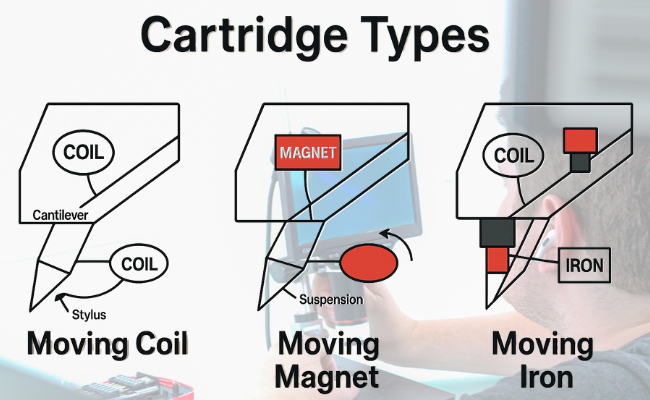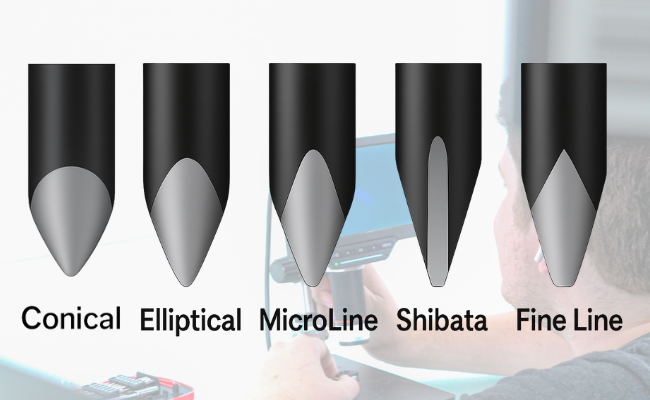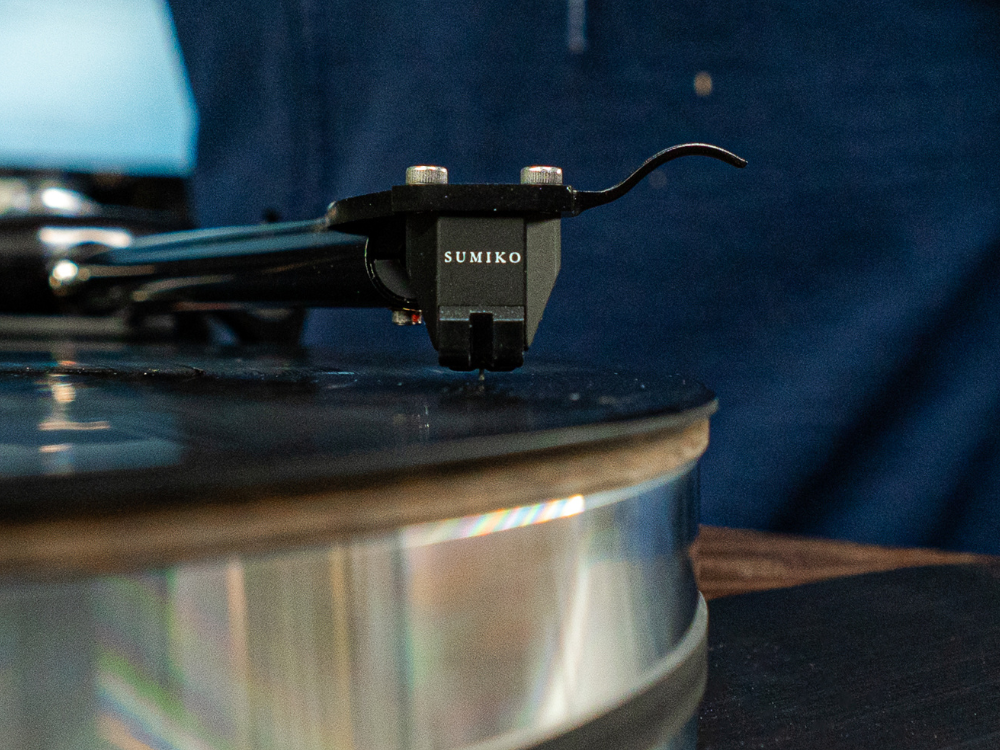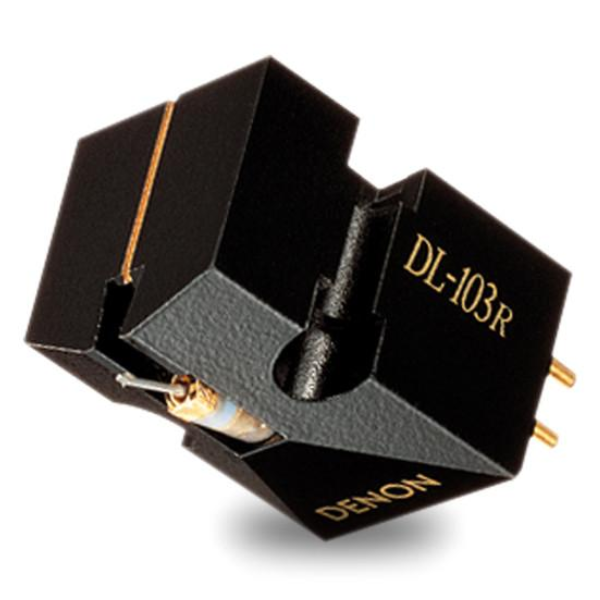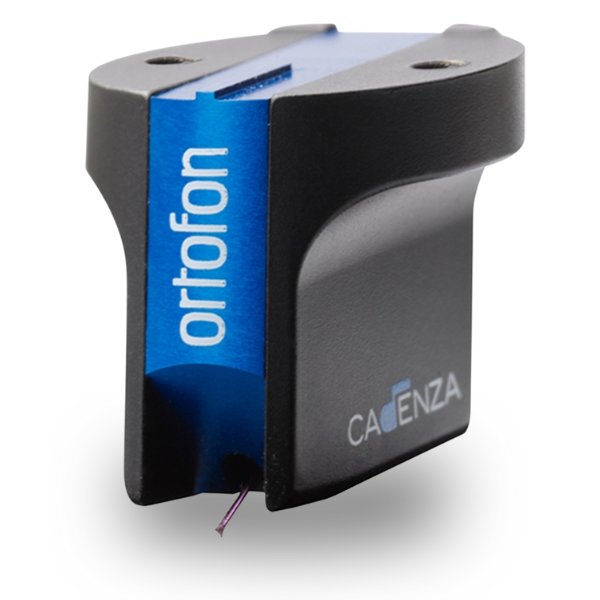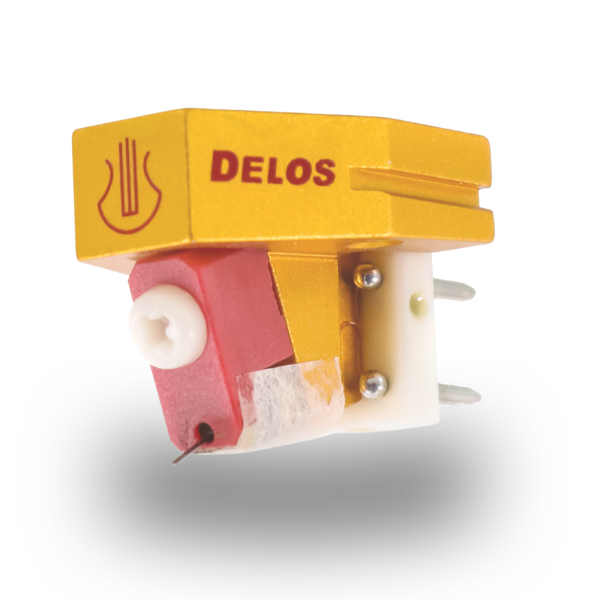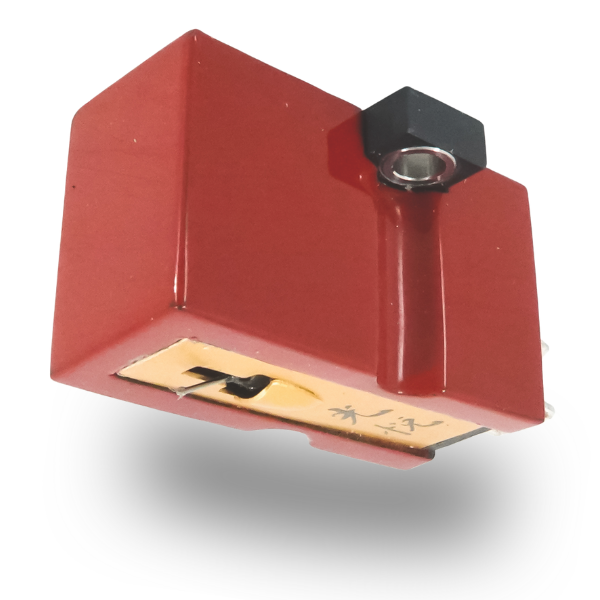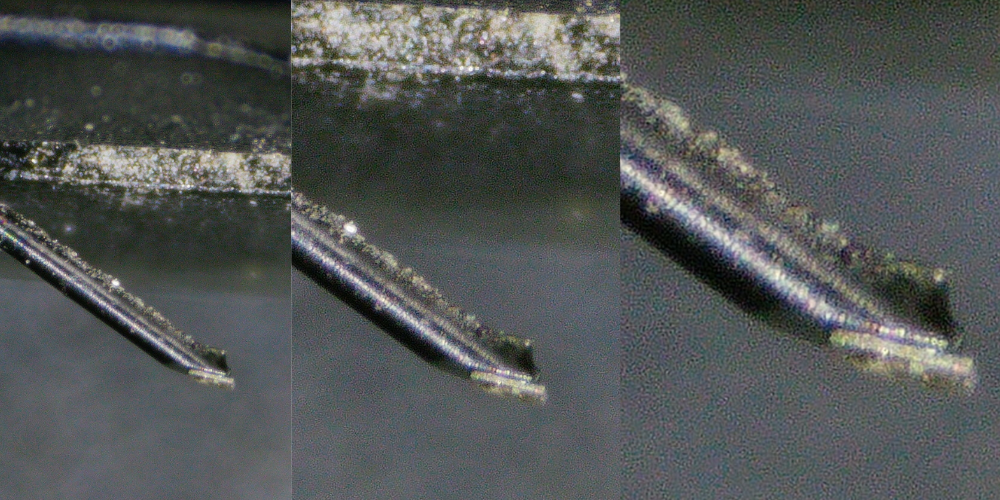Turntable Cartridges 101: What’s the Difference and Which Should You Get?

The unsung hero of vinyl playback, the cartridge is where the spark ignites, the one component that actually touches your records and converts physical motion into an electrical signal. Yet it’s often the most misunderstood (and overlooked) piece of the analog puzzle.
Whether you’re spinning vintage LPs or hunting for high-res analog perfection, your cartridge matters more than you think. And choosing the right one? That takes a little know-how.
What Is a Turntable Cartridge, Really?
A turntable cartridge is a small but critical device that sits at the end of your tonearm and holds the stylus (needle). It’s the first — and arguably most important — link in the analog playback chain.
The stylus rides the grooves of your record, causing tiny vibrations. Inside the cartridge body, those vibrations are converted into an electrical signal that travels through your phono stage, into your amplifier, and finally out to your speakers.
There are different cartridge types and designs, but they all serve the same essential purpose: converting physical movement into music. And how well they do that can dramatically affect your sound — from tonal balance and detail to tracking and groove wear.
In short, the cartridge is your record player’s microphone — it captures everything in the groove, for better or worse.
MM vs. MC — What’s the Real Difference?
Moving Magnet (MM) Cartridges
Moving Magnet Cartridges are the most common and beginner-friendly type of cartridge. They typically offer higher output, which means they’re compatible with nearly any phono stage, and they feature replaceable styli, making long-term maintenance easy. The sound? Punchy, dynamic, and forgiving.
Moving Coil (MC) Cartridges
Purists favor MC cartridges for their transparency and nuance. They tend to have lower output, so they require a compatible phono stage or step-up transformer. Most don’t allow for stylus replacement, but they offer extended highs and improved inner detail.
Moving Iron (MI) Cartridges
Often overlooked, MI designs, such as those from Grado and Soundsmith, blend the convenience of MM with some of the refinement of MCs. They typically have MM-like output, replaceable styli, and a warm, detailed sound that strikes a balance beautifully.
Quick Reference for Cartridge Types:
MM = accessible and flexible.
MC = high-end refinement, but system-matching matters more.
MI = a middle path — MM ease, with some MC-like sound benefits.
Stylus Shapes Explained — And Why They Matter
The shape of your stylus determines how it sits in the groove — and how much musical information it can extract. It affects detail retrieval, tracking ability, record wear, and even how your favorite albums sound when you listen to them.
Here’s a breakdown of the most common stylus shapes, what they sound like, and who they’re best for:
Conical (a.k.a. Spherical)
This is the most basic stylus shape — round-tipped and easygoing. It sits higher in the groove and touches less surface area, which makes it forgiving of surface noise and setup. You’ll find these on many entry-level or vintage cartridges.
Best for: Budget setups, older or worn records, casual listening
Sound: Rounded, fun, but a little soft on inner detail and top-end sparkle
Elliptical
A more refined shape with a narrower contact profile, allowing it to trace the groove more accurately. Elliptical styli enhance resolution and transient response without requiring precise setup.
Best for: Everyday hi-fi systems, mid-tier MM cartridges
Sound: Clearer highs, better detail retrieval, solid channel separation
MicroLine
This stylus shape closely replicates the original cutting stylus used to master records, allowing it to trace the most delicate inner-groove details. It requires precise setup, but it rewards users with remarkable resolution and tracking accuracy.
Best for: High-resolution systems, detail-obsessed listeners, upgraded MM or MC carts
Sound: Exceptional inner detail, excellent channel separation, and cleaner tracking across the entire record — even toward the inner grooves
Shibata
Initially developed for quadraphonic LPs, the Shibata stylus has a broad vertical contact area and an extended side profile. It extracts more from the groove without increasing wear — ideal for dynamic, high-frequency, and heavy recordings.
Best for: Lively systems, MC cartridges, or anyone chasing clarity without harshness
Sound: Open, energetic highs with strong microdetail and a sense of space — can sound thrilling when well-aligned
Fine Line
Fine Line styli are a class of advanced elliptical shapes with longer, narrower profiles. They offer much of the detail-retrieving ability of MicroLine, but with slightly less setup sensitivity, making them a great middle ground.
Best for: High-end MM carts or mid-level MCs where you want detail without fuss
Sound: Clear and focused, with good groove tracing and low distortion — smooth across genres
Pro Tip - Higher-end stylus shapes can unlock serious resolution — but only if your tonearm, alignment, and VTF (vertical tracking force) are dialed in. If you’re not sure your setup is ready, stick with the elliptical until you’re confident in your cartridge setup skills.
Cartridge + Tonearm = Matchmaking 101
You can’t just throw any cartridge on any tonearm and expect magic. For your setup to track properly and sound its best, the cartridge and tonearm need to complement each other — both mechanically and sonically.
One of the biggest factors? Tonearm mass and cartridge compliance.
Tonearm Effective Mass
Every tonearm falls into one of three general categories: low, medium, or high mass. This rating affects how the arm moves in response to the stylus — and how well it can control the cartridge’s suspension. Too light or too heavy, and you risk throwing off the balance.
Compliance: The Cartridge’s Suspension System
Compliance refers to how easily the stylus and cantilever respond to groove modulations — essentially, how “springy” the suspension is. Think of it like shock absorbers on a car:
- High-compliance cartridges have soft suspensions — they need lighter arms to stay controlled
- Low-compliance cartridges have stiffer suspensions — they perform best with heavier tonearms that can push back
Get the Match Right, Or Else…
When you mismatch compliance and tonearm mass, bad things can happen:
- Mistracking – The stylus struggles to stay in the groove, especially on inner grooves or dynamic passages
- Unwanted resonance – A nasty peak in the bass or midrange that muddies everything
- Rolled-off highs or lows – You lose extension, air, or bottom-end impact
- Blurry imaging – Spatial cues get smeared, and focus disappears
In short? It won’t sound right — and worse, you could wear out your stylus (or your records) faster than you think.
Compliance & Tonearm Mass Matching Chart
|
Cartridge Compliance |
Recommended Tonearm Mass |
Sound Traits |
|
High Compliance |
Low Mass (5–10g) |
Light, fast, great inner detail |
|
Medium Compliance |
Medium Mass (10–20g) |
Balanced, punchy, wide compatibility |
|
Low Compliance |
High Mass (20g+) |
Weighty, powerful, excellent tracking |
Rule of Thumb:
- Match light carts with light arms.
- Heavy carts require heavier arms to remain stable.
Popular Cartridge Combos That Just Work
These cartridge-and-tonearm pairings are proven winners — not just technically, but musically. If you’re looking for synergy without the guesswork, start here.
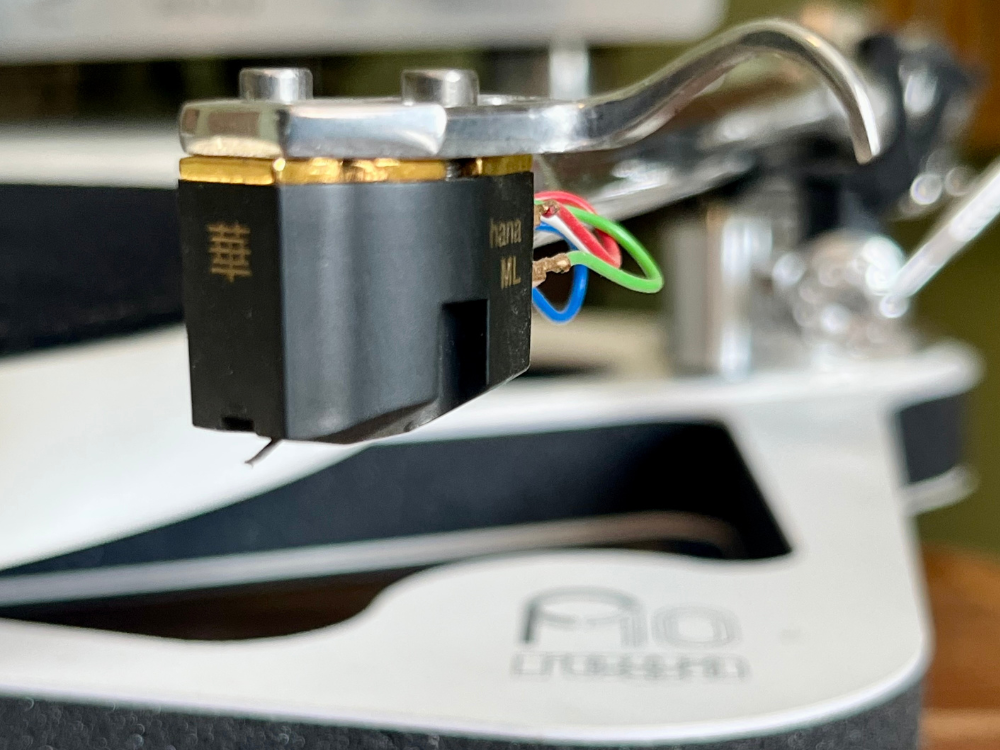 Rega Arms + Rega, Hana, or Goldring Cartridges
Rega Arms + Rega, Hana, or Goldring Cartridges
(e.g., P6 + Exact or Ania)
Rega’s tonearms are designed to work seamlessly with their cartridges — but they also pair beautifully with models from Hana and Goldring: no spacers, no fuss — just great timing, tight bass, and smooth tracking.
Technics SL-1200GR + Ortofon 2M Series
This combo is a modern classic. The SL-1200GR’s medium-mass arm is a perfect match for the 2M Red, Blue, Bronze, or Black — delivering crisp transients and an open, dynamic sound that works across genres.
VPI Unipivots + Denon DL-103R or Hana SL/SH
VPI’s heavier unipivot arms are well-suited for low-compliance MCs. The Denon DL-103R is a longtime favorite, but Hana’s SL and SH offer a more refined, spacious presentation without losing body or drive.
Pro-Ject Arms + Audio-Technica VM540ML
Pro-Ject’s medium-mass arms and the VM540ML’s moderate compliance make for a balanced, high-performance pairing — with excellent tracking and detailed highs that don’t get fatiguing.
Vintage Thorens Arms + Nagaoka MP-110 or Hana EL/SL
Thorens’ classic high-mass arms match beautifully with the forgiving warmth of the MP-110 or the tighter, more revealing sound of Hana’s EL and SL. Either way, you’ll get a smooth, musically engaging ride.
Best Turntable Cartridges by Budget
$500–$1,000 Cartridges
- Ortofon 2M Bronze / Black (Fine Line / Shibata) – Resolving MM with strong imaging
- Denon DL-103R (Conical) – Classic MC tone with upgrade potential
- Hana EL / EH (Elliptical) – Clean, balanced intro to MC
- Goldring 1042 (Gyger S) – Natural tone with superb tracking
$1,000–$2,000 Cartridges
- Dynavector 20X2 H / L (Line Contact) – Fast and full-bodied
- Hana ML / SL MkII (MicroLine) – Open, refined, and tonally balanced
- Ortofon Cadenza Red / Blue (Fine Line / Nude FG 70) – Smooth and detailed
- Goldring Eroica HX / LX (Gyger II) – Precise highs with excellent resolution
$2,000–$5,000 Cartridges
- Lyra Delos / Kleos (Line Contact) – Ultra-revealing and dynamic
- Koetsu Black / Rosewood (Proprietary Line Contact) – Romantic, lush midrange
- My Sonic Lab Eminent (MicroRidge) – Extreme grip and harmonic finesse
- Hana Umami Blue / Red (Special Line Contact) – Deep tone, elegant speed
$5,000+ Cartridges
- Lyra Atlas (Line Contact) – Reference-grade speed and insight
- Koetsu Urushi Vermillion MC Phono Cartridge (Line Contact variants) – Emotional, organic, legendary
- Ortofon MC Anna Diamond (Replicant 100) – Transparent, unforgiving, unforgettable
When Should You Upgrade Your Cartridge?
Knowing when a cartridge has reached the end of its life isn’t always obvious. The most reliable way to determine this is by placing it under a microscope and inspecting the stylus.
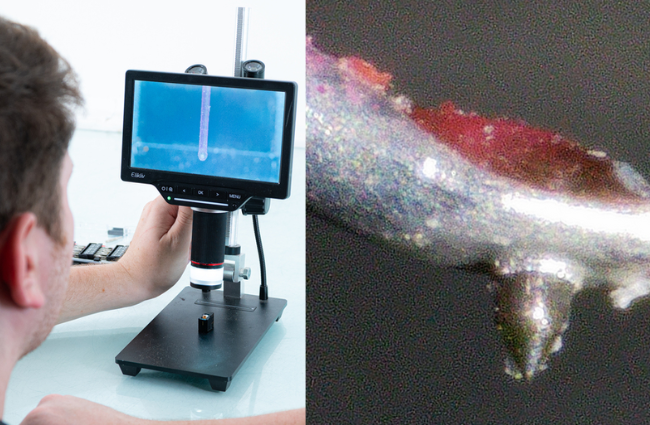
You’re looking to see if it’s still holding its original shape or if it’s been worn down. Over time — much like the tip of a pencil — the stylus slowly loses its precise profile. As it flattens, it can’t track the groove as cleanly, and your sound quality starts to slip.
Sometimes your system tells you it’s time — other times, your ears just know. Here are a few signs that it might be time to move up:
- You’re hearing distortion or mistracking - Sibilance, inner-groove fuzz, or a stylus that jumps or skates? These are red flags.
- The stylus shows visible wear or damage. - A worn stylus can harm your records — and your sound. If it’s been years (or hundreds of hours), it’s worth inspecting.
- Your system has outgrown it. - If you’ve upgraded your amp, speakers, or phono stage, your old cart might be the weak link.
- You’re craving a different sound. - Looking for more warmth? Better bass? Greater inner detail? A cartridge swap can completely transform your sonic landscape.
- You want better tracking or groove retrieval. - Advanced stylus shapes (like MicroLine or Shibata) can reveal what your current setup is missing.
Bottom line: If your vinyl sounds flat, brittle, or just not as engaging as you remember — don’t blame the records. It might be your cartridge quietly asking for retirement.
Final Thoughts: As Always – Let Your Ears Lead the Way
There’s no “perfect” cartridge, only the one that works best for your system, your music, and your ears. The right match can transform your table, lift the veil off your records, and bring the groove back to life. If you have a little more time a want a great read, "What If Vinyl Was All We Had?" by Dan Wrigt of Modwright Instruments
Love insights like this?
From deep dives on turntables and cartridges to the hottest fresh arrivals in hi-fi from all over the world, our newsletter delivers it straight to your inbox.
Get expert tips, exclusive offers, and first dibs on rare gear — before it’s gone.
Join the Conversation
